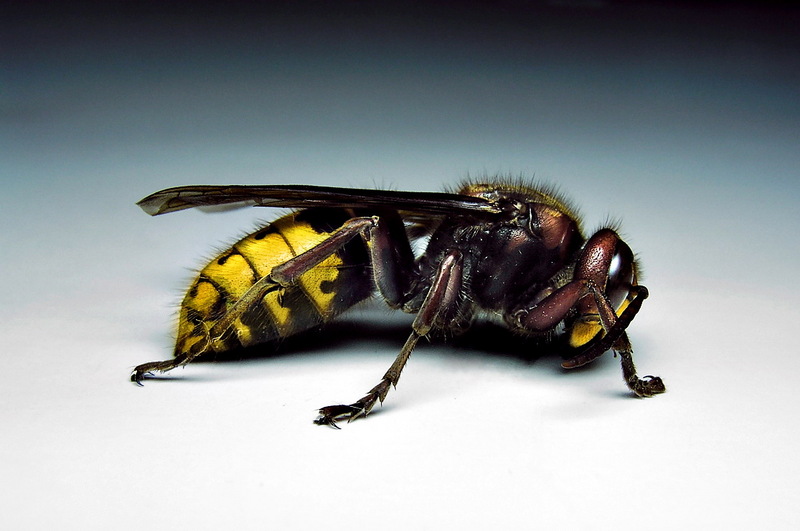European Hornet (Vespa crabro) - Wiki European hornet
From Wikipedia, the free encyclopedia
[Photo] A female European hornet. From head to tail, this hornet was approximately 7/8 of an inch long. Date 2005-09-24. Author Piccolo Namek http://en.wikipedia.org/wiki/User:PiccoloNamek
The European hornet Vespa crabro is the largest European eusocial wasp, commonly known simply as the "hornet". This is not to be confused with the colloquial use of hornet for the bald-faced hornet, or other yellowjackets in other countries. The queen measures 25 to 35 mm long, males and workers are smaller. In males, as in most members of the Aculeata, the antennae have 13 segments, while in females there are only 12; also as in other aculeates, the male abdomen has seven visible segments, while the female has six; females possess an ovipositor modified into a sting which is not barbed. See wasp and bee characteristics to help identify similar insects.
This species is not particularly aggressive except when defending the nest, and care must be taken when in proximity, as the stings are quite painful. As with most stinging insects, they will sting in self-defense when grabbed or stepped on.
Description
Eyes are deeply indented, shaped like a C. Wings are reddish-orange, the petiolate abdomen is brown striped with yellow. The European hornet is larger than a yellowjacket but smaller than some Asian hornet species, and has hair on the thorax and abdomen, although is not as hairy as most bees.
European hornets often have the rove beetle Velleius dilatatus living in their colonies.
Relationship with humans
Myths
European Hornets are often (although wrongly) thought to be very aggressive and dangerous, and are greatly feared by some people. Some people believe that "three stings from the European hornet can kill an adult human, and that seven can kill a horse". These are common myths - a sting from a European hornet isn't any more dangerous than a wasp sting, and hornets are less aggressive than wasps. In contrast, multiple Asian giant hornets stings are, in fact, more dangerous.
Gentle Giants
While impressive due to their size and loud sound, European hornets are in fact much less aggressive than some of their smaller relatives, notably the yellowjackets, Vespula germanica and Vespula vulgaris. When approached, European hornets can actually be seen to slowly crawl backwards and eventually flee, rather than attacking. This can make it hard to remove hornets from indoors, if they happen to come in through an open window or door. While not aggressive when encountered far from the nest, multiple workers will vigorously defend the nest if provoked. Nests can be approached without provocation (moving slowly and not breathing towards the nest) to about 50 cm. Nests are usually not a problem outside buildings, but because they drip faeces, a bad smelling black liquid, nests inside sheds or walls can be a problem.
Endangered Species and Legal Protection
Unwarranted fear has often led to the destruction of nests, leading to the decline of the species, and is often locally threatened or even endangered. European hornets benefit from legal protection in some countries, notably Germany, where it is illegal to kill a European hornet or nest since 1st January 1987, with a fine up to 50,000 Euros.
Attraction to lights and food
European hornets are attracted to lights at night, but are not attracted to human foods and food wastes. This is the opposite of the bald-faced hornet or other yellowjackets.
Geographic colour forms
European hornets worldwide are found with geographic colour forms:
Vespa crabro crabro Linnaeus, 1758
Vespa crabro vexator Harris, 1776
Vespa crabro germana Christ, 1791
Vespa crabro crabroniformis Smith, 1852
Vespa crabro borealis Radoszkowski, 1863
Vespa crabro oberthuri du Buysson, 1902
Vespa crabro flavofasciata Cameron, 1903
Vespa crabro altaica P??rez, 1910
Vespa crabro caspica P??rez, 1910
Vespa crabro chinensis Birula, 1925
http://en.wikipedia.org/wiki/European_hornet
| The text in this page is based on the copyrighted Wikipedia article shown in above URL. It is used under the GNU Free Documentation License. You may redistribute it, verbatim or modified, providing that you comply with the terms of the GFDL. |
